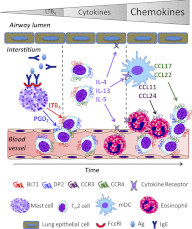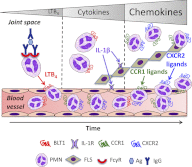Lipid-cytokine-chemokine cascades orchestrate leukocyte recruitment in inflammation
- PMID: 22058421
- PMCID: PMC3290425
- DOI: 10.1189/jlb.0811402
Lipid-cytokine-chemokine cascades orchestrate leukocyte recruitment in inflammation
Abstract
Chemoattractants are pivotal mediators of host defense, orchestrating the recruitment of immune cells into sites of infection and inflammation. Chemoattractants display vast chemical diversity and include bioactive lipids, proteolytic fragments of serum proteins, and chemokines (chemotactic cytokines). All chemoattractants induce chemotaxis by activating seven-transmembrane-spanning GPCRs expressed on immune cells, establishing the concept that all chemoattractants are related in function. However, although chemoattractants have overlapping functions in vitro, recent in vivo data have revealed that they function, in many cases, nonredundantly in vivo. The chemically diverse nature of chemoattractants contributes to the fine control of leukocyte trafficking in vivo, with sequential chemoattractant use guiding immune cell recruitment into inflammatory sites. Lipid mediators frequently function as initiators of leukocyte recruitment, attracting the first immune cells into tissues. These initial responding immune cells produce cytokines locally, which in turn, induce the local release of chemokines. Local chemokine production then markedly amplifies subsequent waves of leukocyte recruitment. These new discoveries establish a paradigm for leukocyte recruitment in inflammation--described as lipid-cytokine-chemokine cascades--as a driving force in the effector phase of immune responses.
Figures



References
-
- Edwards S. W., Hallett M. B. (1997) Seeing the wood for the trees: the forgotten role of neutrophils in rheumatoid arthritis. Immunol. Today 18, 320–324 - PubMed
-
- Santodomingo-Garzon T., Swain M. G. (2011) Role of NKT cells in autoimmune liver disease. Autoimmun. Rev. 10, 793–800 - PubMed
-
- Ajami B., Bennett J. L., Krieger C., McNagny K. M., Rossi F. M. (2011) Infiltrating monocytes trigger EAE progression, but do not contribute to the resident microglia pool. Nat. Neurosci. 14, 1142–1149 - PubMed
-
- Cantor J., Haskins K. (2007) Recruitment and activation of macrophages by pathogenic CD4 T cells in type 1 diabetes: evidence for involvement of CCR8 and CCL1. J. Immunol. 179, 5760–5767 - PubMed
-
- Mantovani A., Cassatella M. A., Costantini C., Jaillon S. (2011) Neutrophils in the activation and regulation of innate and adaptive immunity. Nat. Rev. Immunol. 11, 519–531 - PubMed
Publication types
MeSH terms
Substances
Grants and funding
LinkOut - more resources
Full Text Sources
Other Literature Sources

